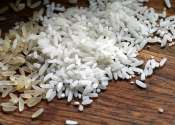US drinking water often contains toxic contaminants, scientist warns
Most Americans take it for granted that the water that comes out of their taps is clean and safe to drink.

Most Americans take it for granted that the water that comes out of their taps is clean and safe to drink.
Environment
Oct 4, 2023
1
467

Rice is the most widely consumed staple food source for a large part of the world's population. It has now been confirmed that rice can contribute to prolonged low-level arsenic exposure leading to thousands of avoidable ...
Environment
Aug 4, 2020
0
863

Contamination of rice with arsenic is a major problem in some regions of the world with high rice consumption. Now, researchers reporting in the ACS journal Environmental Science & Technology have found a way to reduce inorganic ...
Environment
Apr 17, 2019
0
14

A team of researchers at the University of Delaware has found that incorporating rice husk to soil can decrease toxic inorganic arsenic levels in rice grain by 25 to 50 percent without negatively affecting yield.
Other
Jun 8, 2016
0
564
Seaweed has been eaten for thousands of years by people all over the world, and it can be considered a tasty and healthy food item. This is the conclusion from professor Ole G. Mouritsen, Department of Physics, Chemistry ...
Ecology
Apr 30, 2013
0
0

The use of water contaminated with higher than recommended levels of arsenic could pose a serious health risk to millions, a new study from the University of Sheffield has found.
Environment
Mar 21, 2024
0
31

In January 2016, the EU imposed a maximum limit of inorganic arsenic on manufacturers in a bid to mitigate associated health risks. Researchers at the Institute for Global Food Security at Queen's have found that little has ...
Environment
May 4, 2017
0
59

(Phys.org) —Amphibians living in an old mine tailings site near Upper Seal Harbour, Nova Scotia, show high levels of arsenic after being tested using synchrotron light, leading scientists to believe these animals could ...
Environment
Oct 18, 2013
0
0
Naturally-occurring arsenic in Bangladesh's groundwater has been identified as one of the world's great humanitarian disasters, with millions people at risk of cancers and other diseases from drinking water and eating rice ...
Analytical Chemistry
Jul 14, 2016
0
8

Significantly higher arsenic and uranium concentrations in public drinking water have been linked to communities with higher proportions of Hispanic/Latino, American Indian/Alaskan Native, and non-Hispanic Black residents, ...
Environment
Dec 14, 2022
0
87